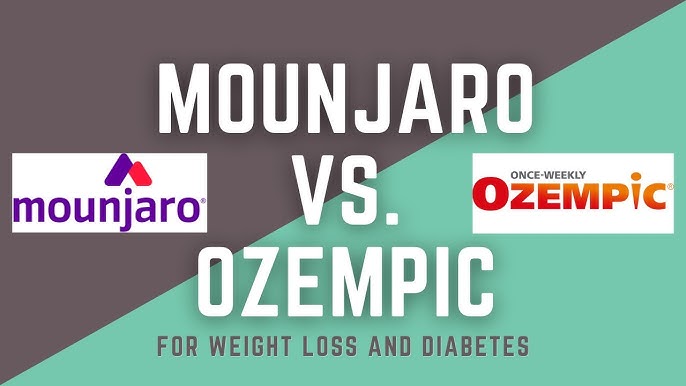When it comes to managing type 2 diabetes, there are several treatment options available. Two popular injectable medications, Ozempic and Mounjaro, are commonly prescribed to help regulate blood sugar levels.
However, these medications have distinct characteristics and considerations, making it essential to choose the one that best suits your needs.
Comparing the Active Ingredients
Ozempic and Mounjaro, despite serving similar purposes, cannot be used interchangeably due to their differing active ingredients and mechanisms of action. Please Fill out this form to check if you or a friend qualify for Continuous Glucose Monitors.
Ozempic: Contains semaglutide, which mimics the body’s glucose-like peptide (GLP)-1 hormones.
Mounjaro: Contains tirzepatide, which mimics both GLP-1 and glucose-dependent insulinotropic polypeptide (GIP) hormones, often referred to as “twincreatin” due to its dual hormone mimicry. The interaction of GIP hormones with GLP-1 hormones enhances their impact on digestion and metabolism, aiding in appetite regulation and preventing overeating.
Must Read CGMs in noncritical care hospitals optimizes glycemic control
Indications for Ozempic and Mounjaro
Both Ozempic and Mounjaro are used in the treatment of type 2 diabetes. These injectable medications are administered subcutaneously, just beneath the skin, and offer several benefits:
- Improved insulin sensitivity and reduced insulin resistance.
- Slower digestion and appetite suppression, often resulting in weight loss.
- Lowering the risk of heart attack and stroke in individuals with type 2 diabetes and heart disease.
- Off-label use to enhance insulin resistance, control blood sugar levels, and promote weight loss. However, it’s
- important to note that neither medication is FDA-approved for weight loss.
- It’s essential to understand that you should only take one of these medications, never a combination of both.
Similarities between Ozempic and Mounjaro
Ozempic and Mounjaro share common attributes:
Blood Sugar and A1C Reduction: Both medications have proven to lower blood sugar and A1C levels by increasing insulin secretion, preventing the liver from releasing glucose into the bloodstream, and improving insulin sensitivity.
Potential for Weight Loss: Although not approved as weight loss drugs, studies indicate that both medications can aid weight loss. Ozempic suppresses appetite and slows digestion, while Mounjaro has demonstrated weight loss results in various doses.
Read Guide about Wegovy Dosage Guide: The Best Way For Weight Loss
Lowered Cardiovascular Risks: These medications support cardiovascular health, as they can reduce cholesterol levels and lower the risk of heart-related issues, making them particularly valuable for individuals with type 2 diabetes and heart disease.
Possible Adverse Side Effects: Mild to severe side effects, especially when initially starting the medication, may include nausea, vomiting, diarrhea, constipation, and low blood sugar, particularly when used with insulin. Serious side effects can include pancreatitis, kidney problems, an increased risk of thyroid cancer, and allergic reactions.
Coexistence with Insulin: Ozempic and Mounjaro do not replace insulin, so you may still need to take your other prescribed diabetes medications.
Flexible Administration: Unlike insulin, these medications do not cause acute low blood sugar levels and can be taken with or without food.
Diabetic Retinopathy Consideration: Both medications may cause or worsen diabetic retinopathy in some cases, so individuals with early-stage diabetic retinopathy should consult with their doctor regarding potential risks.
Also, read about Apple’s Health Tech: Blood Sugar Monitoring Ambitions to Industry Challenges
Key Differences Between Ozempic and Mounjaro
To make an informed choice, it’s crucial to consider the differences between Ozempic and Mounjaro:
Dosing: Ozempic and Mounjaro have distinct dosing schemes that are not interchangeable. Ozempic begins at 0.25 mg once per week for the first four weeks, followed by 0.5 mg once per week, with higher doses available.
Mounjaro has its own dosing regimen based on its active ingredient. Attempting to interchange doses can be dangerous.
Active Ingredients: Both Ozempic and Mounjaro contain active ingredients, but Ozempic’s active ingredient is semaglutide while Mounjaro’s active ingredient is tirzepatide. Inform your doctor of any allergies to these active ingredients to ensure they prescribe a suitable medication.
Switching Medications: If necessary, you may switch between these medications under your doctor’s guidance. However, there is a specific waiting period between transitioning from one medication to another, and the dosing is adjusted according to the new medication.
Reduced Diabetes Medications: While weight loss can improve insulin resistance and blood sugar levels, it may not eliminate the need for other diabetes medications entirely. Consult your doctor regarding adjustments to your treatment plan.
Remember that these considerations apply to individuals with type 2 diabetes, as those with type 1 diabetes will continue to depend on insulin for life. Always consult your healthcare provider for personalized guidance on managing your diabetes.


